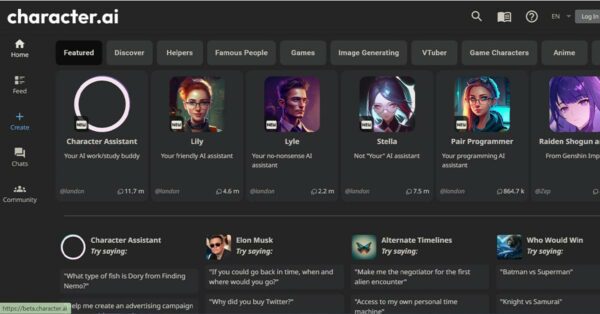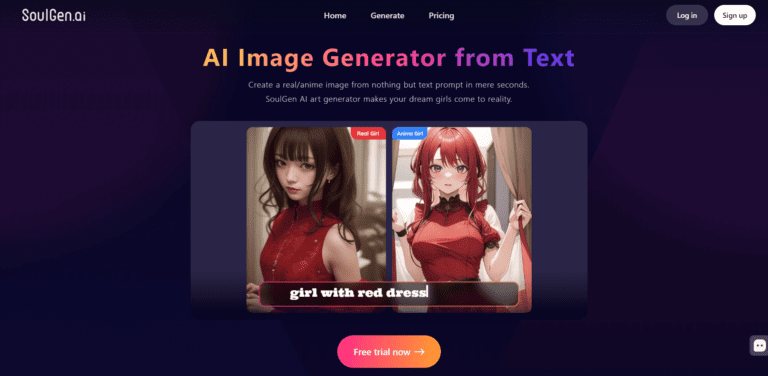Creating actions in character AI is a delicate balance between technical prowess and creative vision.
The art of breathing life into digital characters sometimes seems daunting, but creating relatable, human-like interactions is incredibly fulfilling once you get the hang of it.
Whether it’s a simple gesture or a complex interaction, the ability to craft behaviors that align with unique personalities is what sets character AI apart.
Character AI allows developers to push the envelope in creating dynamic, engaging content that users can’t get enough of.
With this in mind, we will be exploring the nitty-gritty details of how to master the art of crafting actions in character AI.
We will be delving into essential techniques, best practices, and real-world examples to equip you to bring your virtual characters to life.
So, prepare for an exciting journey where innovation and imagination combine to produce digital content that exceeds expectations.
Table of Contents
What is Character AI?

Character AI, or Artificial Intelligence characters, are virtual entities that simulate human-like behaviors and decisions within games, simulations, or other digital environments.
These characters are designed with rules and algorithms and sometimes with machine learning algorithms to respond to various situations realistically and dynamically.
A pivotal part of interactive gaming and storytelling, Character AI adds depth and immersion, allowing users to engage with the virtual world more meaningfully, exciting, and personalized.
The sophistication of Character AI ranges from simple scripted responses to complex adaptive behaviors that allow characters to learn, adapt, and evolve based on user inputs and environmental changes.
What are the Benefits of Using Character AI?
Character AI offers many benefits that enhance user engagement and gaming experience.
Firstly, it enables the creation of immersive, dynamic environments.
AI characters that can learn, adapt, and respond realistically make the virtual world more engaging and unpredictable, adding to the game’s thrill. Secondly, Character AI allows for personalization.
As the characters adapt to user inputs, each player has a unique experience tailored to their actions and decisions.
This level of personalization can improve user satisfaction and increase replay value. Thirdly, Character AI opens up opportunities for deeper storytelling.
With AI characters that exhibit distinct personalities and evolve, developers can create intricate plot lines and character arcs that keep players invested in the game.
Finally, the use of Character AI can make game development more efficient.
By automating character responses and behaviors, developers can streamline the game creation process and free up resources for other aspects of game design.
How to Do Action in Character AI: Step-by-Step Process

Step 1: Be Specific
When designing actions for your character AI, it’s crucial to be specific in defining their behavior.
Start by outlining the detailed characteristics that make your character unique.
This could include traits like their temperament, habits, or quirks.
Then, identify what kind of actions align with these characteristics.
For instance, a brave character might confront danger head-on, while a shy character might prefer evasion or stealth.
The more specific you are in defining your character’s traits and corresponding actions, the more believable and engaging they will be to players.
Remember, the goal is to create a character that exhibits consistent, predictable behavior in line with their defined traits, enhancing the realism and immersion of your game.
Step 2: Use Vivid Language
The ability to effectively convey your characters’ actions largely hinges on your choice of language.
Use vivid, descriptive language when designing and communicating their actions to ensure your audience fully comprehends and engages with your character AI.
Let’s consider an AI character who is running away from danger.
Instead of just stating the character “runs away,” you might describe it as “the character’s heart pounds in their chest as they sprint towards the safety of the shadows, their breath ragged, and eyes wide with fear.”
This rich, evocative language paints a clear picture of the action, fostering a more immersive and emotionally resonant experience for the user.
Remember, your language choices should also align with the character’s unique traits and the overall tone of your game.
Step 3: Use Emotion and Formatting
Effectively conveying emotion can significantly enhance the believability and relatability of your character AI.
Try encapsulating how the character feels in response to different scenarios and how those emotions drive their actions.
For instance, an angry character might act impulsively, while a fearful character might hesitate or avoid confrontation.
Expressive language can further emphasize these emotional states and their impact on character actions.
In addition to using emotion, proper formatting is essential in presenting your character’s actions clearly and coherently.
Use appropriate line breaks, spacing, and indentation to structure your descriptions and accentuate important details.
Utilize bullet points or numbered lists to outline multi-step actions or complex behaviors.
Also, consider incorporating visual aids such as diagrams or flowcharts to illustrate more complex sequences of actions or decision-making processes.
These formatting techniques make your descriptions more readable and offer a more user-friendly experience for developers implementing your character AI actions.
Helpful Tips on How to Do Action in Character AI

- Create Realistic Reaction Sequences: A character’s action should feel like an authentic reaction based on their personality traits and situation. Avoid actions that feel forced or inconsistent with their defined character traits.
- Implement Variety in Responses: Characters become more engaging and lifelike if they exhibit various responses to different situations. Consider implementing randomization within specific parameters to make your character’s reactions feel less predictable and more dynamic.
- Incorporate Environmental Interactions: Characters interacting with their environment add to the realism. This interaction can be as simple as a character sitting on a nearby chair or as complex as using a tool in the environment to overcome a challenge.
- Use Sound and Animation to Enhance Action: Visual and auditory cues can immensely enhance the impact of character action. Consider how a character’s movement, facial expression, or even the sound of their voice can make their actions more expressive and engaging.
- Test, Iterate, and Refine: The development of character AI is a cyclical process of design, testing, and refinement. Observe how your AI characters behave during gameplay, gather feedback, and continually refine their actions to improve realism and player engagement.
- Consider the Game’s Narrative: Remember that character actions should serve the broader narrative of the game. Ensure that character actions align with and enhance the game’s story, theme, and overall progression.
- Collaborate with Other Designers: Collaboration is critical in creating compelling character AI. Work closely with your team, including artists, animators, sound engineers, and other designers, to ensure that your character’s actions are well-integrated and coherent in the overall game design.
FAQs
How is AI Character Monetized?
AI characters can be monetized in several ways in the gaming industry. One of the most common methods is through in-app purchases.
Developers can create premium AI characters with unique abilities or features that gamers can purchase.
The rarity or prowess of these characters can command higher prices, driving revenue.
Additionally, subscriptions can offer gamers access to exclusive characters or upgrades.
Another strategy is sponsorships and partnerships, where AI characters can be designed based on popular franchises or celebrities, and the game developers earn revenue through these collaborations.
Lastly, advertising can be used, particularly in free-to-play games. Here, players may watch ads in exchange for in-game rewards or enhancements for their AI characters.
Is Character AI Safe?
Yes, Character AI is generally safe.
However, as with any technology, there are potential risks that developers and users should be aware of.
Potential issues could include privacy concerns, as some character AI systems may need to collect user data to function optimally.
Additionally, there is the risk of AI being used maliciously, such as in creating deepfakes or other forms of digital deception.
Game developers must prioritize user safety and data privacy when designing and implementing character AI.
They should ensure that any data collected is stored securely and used ethically and their AI cannot be easily exploited or manipulated for malicious purposes.
Character AI can provide a safe and enriched gaming experience as long as these precautions are taken.
Wrapping Up
In conclusion, developing robust character AI is a complex but rewarding process that can significantly enhance the player’s gaming experience.
Using techniques such as descriptive language, emotional resonance, and strategic formatting, you can create lifelike, immersive characters that engage players on a deeper level.
Remember, the essential lies in creating actions that are believable, varied, and aligned with the narrative of the game.
Collaboration with other team members and continual iteration based on feedback is crucial for refining your character AI.
As technology advances, the possibilities for character AI continue to expand, opening up new opportunities for creativity and innovation in the gaming industry.





